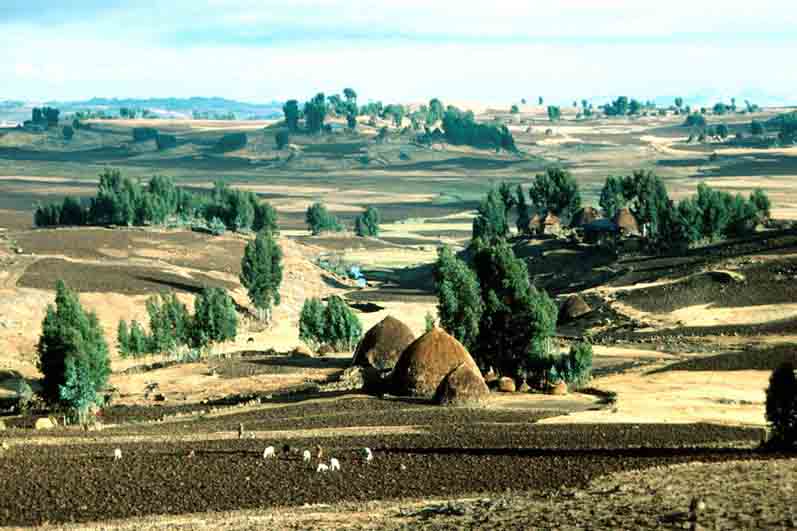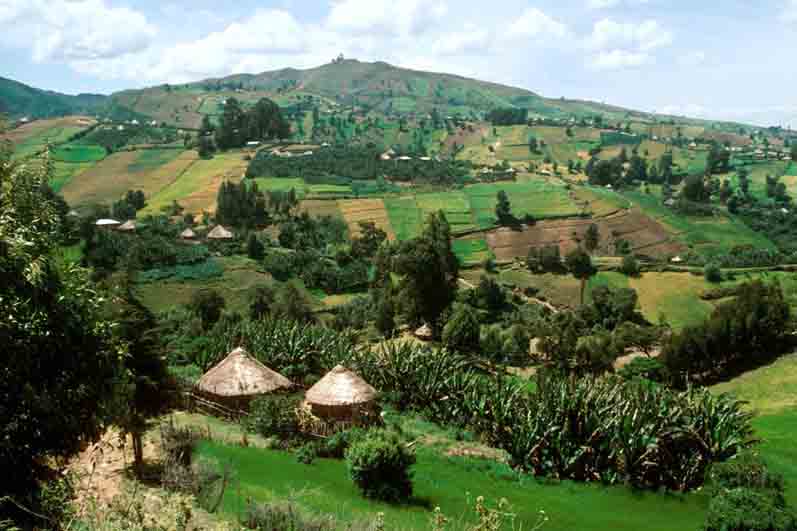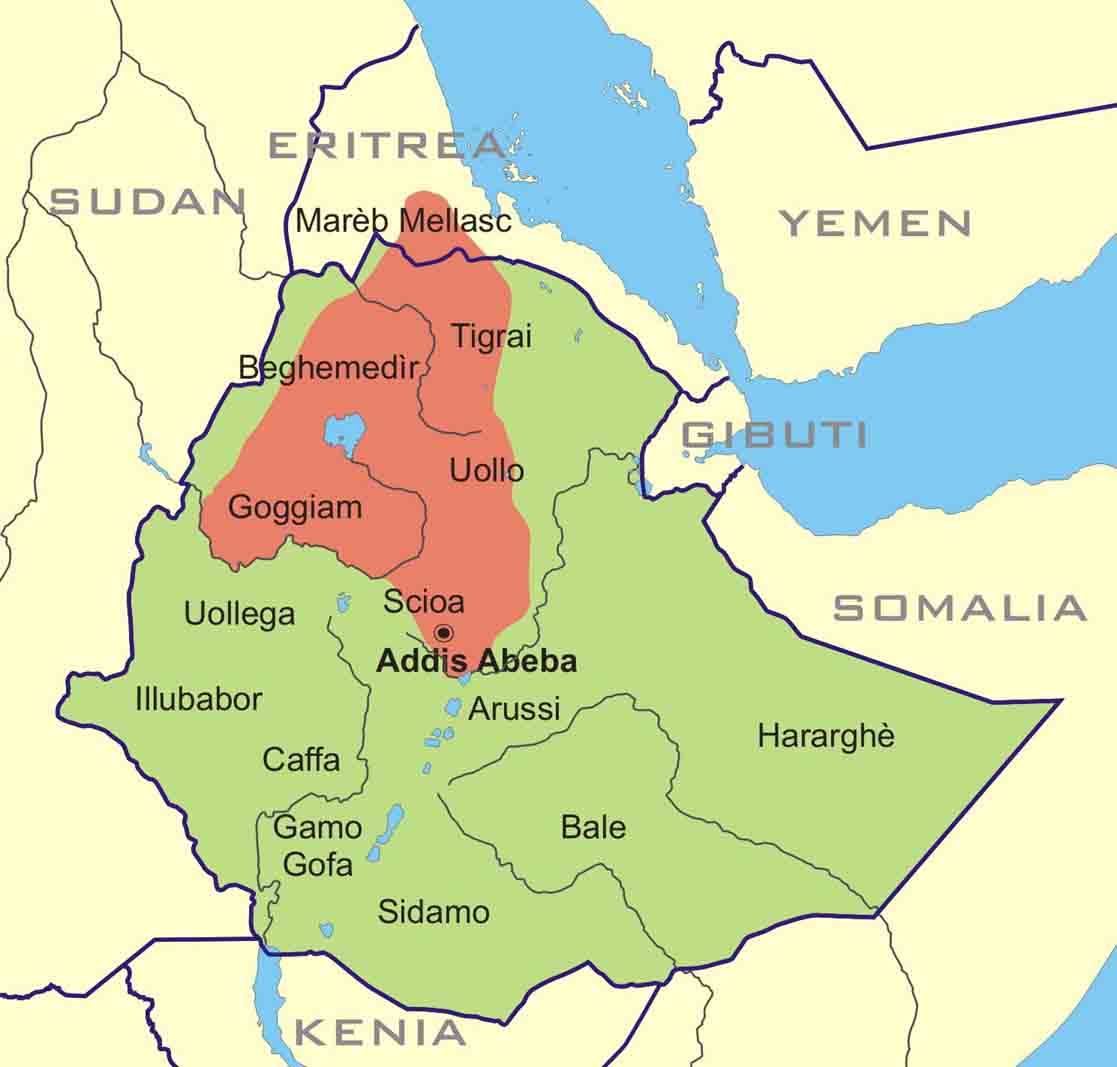Alberto Vascon & Nicky Di Paolo
6/8/04
The term Abyssinia is lately regarded with disfavour by Eritreans and even some Ethiopians. We have received various reports in this sense, and we would like to discuss the problem because it seems inappropriate to let this word, with all its history, nobility and fascination, fall into disuse. The term is used today in the West with a mixture of respect and awe.
Abyssinia is derived from Habashat, one of the south Arabian tribes that took part in founding the Kingdom of Axum, also known as the Kingdom of the Habashat. The Abyssinians are the descendants of the Axumites. In Arab the term habash means “mixture of populations”. Abyssinia is the immense region occupying most of the Ethiopian plateau, namely the area extending from the bastions facing the Sudan to all the Eritrean highland, the provinces of Tigray, Begemeder, Gojam and most of the Shewa in Ethiopia. In other words, all the Ethiopian plateau north of the Awash river and the Blue Nile.
It is now known that Semitic populations from Arabia settled on the African highlands in the first millennium BC and integrated with the local peoples, giving rise to the Abyssinian stock, a people with semitic features and dusky skin, much fairer than the other African populations. These people founded the Kingdom of Axum. About 50 BC an anonymous Levantine compiled a portulan entitled “Circumnavigation of the Eritrean Sea”. Although in those times the Eritrean Sea included the present Red Sea as well of much of the Indian Ocean, the author dedicated few pages to the African coasts compared to what he wrote about the coasts extending from Arabia to India. This suggests that Africa was then rarely considered by navigators. Adulis, situated opposite the “country of the Arabs”, is the only city on the African coast mentioned in the document. Adulis was known for trade in ivory, rhinoceros horns, turtle shells, incense, myrrh, civet, cinnamon, elephants and slaves, all products in great demand in advanced countries of the day. The ruins of the port are still visible near Zula, a town on the Eritrean coast about 40 km south of Massawa. The period of prosperity of Adulis was in the IV century, when Axum, the capital of the Axumite civilisation, was at its peak. The capital of Axum was only 200 km from Adulis, but it was far enough to place it in a completely different world. Indeed, although the maritime town was the port of the horn of Africa, the ancient Ethiopians preferred the climate of Axum, at an altitude of 2100 metres.
According to recent scholars, the fact that only one civilisation developed in subsaharan Africa in prechristian times, namely that of the ancient Abyssinians, was due solely to its geography. Abyssinia is on one of the greatest high plains in the world. In a relatively small space, it includes 50% of the mountains in Africa above 2000 m in height and 80% of those over 3000 m. Thirty-one mountains are more than 4000 m high, the highest, Ras Dashan, reaches 4620 m, and about 60 peaks are over 3000 m. At such great heights and low latitudes, spring weather is enjoyed all year round, there is plenty of rain and fewer of the tropical diseases that devastate Africa.
Until a few decades ago, Abyssinia had the greatest number of plant species in the world, many endemic, and the greatest variety of birds, together with a vast assortment of animals and insects. The great Ethiopian high plain is divided by the Rift Valley, where a unique ecosystem hosts an enormous variety of animal and plant species. This extraordinary place is where the human race first evolved. Lucy was found in the Awash valley. The horn of Africa is therefore the cradle of man.
Much later, when humans had populated all parts of the Earth, the morphology of the plateau was practically impossible for aggressive neighbouring peoples: its impenetrable mountains defended it to north, east and west, while in the south, the Somali desert discouraged intruders. These were all ingredients for the development of what ancient historians knew as the Land of the Habashat, a civilisation with writing and coins, that traded with the rest of the world and built monuments that have lasted thousands of years. The tallest of the famous obelisks of Axum is 33.5 metres high, with a base measuring 3 x 2 m and a weight of more than 500 tons. It is the largest monolith ever cut, transported and erected in antiquity. It remains a mystery how it was transported 4 km from the quarry where its imprint is still visible. Even today, it would be a technological and scientific challenge to transport and erect it. The cult of the dead, the rich quality of life and the search for knowledge brought renown to the Kingdom of Axum. According to ancient Persian and Roman historians, Persia, Rome, Abyssinia and China were the four great kingdoms at the time of Christ.
While the Ethiopian plateau had all the conditions for the birth of civilisation, it is difficult to understand why nothing similar developed in Kenya, where similar places with similar climate exist. The reason is presumably that there was no immigration from southern Arabia. There have therefore always been great possibilities for life in the horn of Africa, but only on the plateau, in Abyssinia, whereas on the coast and other low areas, life has always been problematical because of heat and lack of water.
Christianity reached Abyssinia not much later than it reached Rome, but developed there much more readily, suggesting a receptivity that only a great civilisation can create. The legendary Axumite civilisation was short lived: 400 years after the arrival of Christianity, namely in the 7th century AC, it was suddenly eclipsed. The reasons were presumably many and not all of them have yet been clarified. In the 7th century AC, there was a sudden climatic change throughout Abyssinia. In the horn of Africa, monsoons normally blow from SW in the period May-September, followed by an inversion to northeasterlies from November to April. These winds were exploited by Arabs and Indians to sail eastward in winter and spring and return the following summer and autumn. We now know that in the first century AC the monsoon also reached the Ethiopian high plain, causing at least seven full months of rain each year. This enabled at least two crops per year, often three, and the growth of dense forests over at least half of the plateau. Enormous quantities of water drained from the mountains towards the deserts and the sea in large rivers that modelled the land and the coastline. Near Adulis, two of these rivers extended the land and silted up the sea, making navigation difficult. When the monsoons suddenly ceased to reach the high plain in the 8th century, the wet season was reduced to only three months of the year and annual rainfall dropped sharply. Axum found itself without a port and with serious drought problems, whence its decadence. The end of the Kingdom of Axum was decreed by the Arab conquest of Egypt, which removed Adulis from the trade route to India. The invasion by the Beja tribes and the destructions brought from the Agaw queen Gudit from Damot in the X century completed the fall of Axum. Abyssinia remained isolated from the rest of the world for nearly 800 years, until the dynasty of the King of Gonder raised it from obscurity.
It is worth adding that in the year 400, Christianity came to Abyssinia through Saint Frumentius and Abyssinia converted while neighbouring populations remained “pagan”, later to be converted to Islam.
When the Italians landed at Massawa at the end of the 19th century, forests covered 30% of Abyssinia, and not much else had changed for hundreds of years. The dominant people, of Christian religion, had maintained a level of civilisation which they exploited to subjugate the various Ethiopian tribes, and it was only with much effort that they succeeded in holding together a kingdom three times the area of France. The Italians arrived quietly, timid in their youth, inexperienced in politics, ignorant of African affairs and colonial missions, lacking the background and logistics of other colonialist countries such as England and France. They were driven largely by emulation, pride and fear of missing out on a slice of the black continent. Ingenuous as they were, they stumbled into the only once civilised part of subsaharan Africa and the only part that had succeeded in defending itself for thousands of years against intruders.
The Italian adventure in Eritrea lasted for various decades with ups and downs, resolving suddenly between 1936 and 1941 with the conquest of Ethiopia, followed almost immediately by loss of its whole colonial empire. The history of Italian civilians in Eritrea continued until the end of the 1970s, when hostilities between Eritrea and Ethiopia forced Europeans to repatriate.
Today the term Abyssinia is rejected by Eritreans and some Ethiopians and the ill defined borders of Abyssinia are no longer of political significance. Abused by Italian colonialists, the term is no longer pleasing to the present people of the horn of Africa. However, in our opinion, this is not sufficient reason to delete a term of universal importance. The people of the high plain should be proud to be known as Abyssinians, no less than Mediterraneans are known as Latins. Abyssinia is still an intelligent and ancient name for the land of the legendary Habashat or Axumites, the Kings of Gonder and the Christian culture in the horn of Africa. It could be a good reason to forget the differences persisting among Abyssinian people!
Abyssinian lanscapes

Photo by Alberto Vascon


